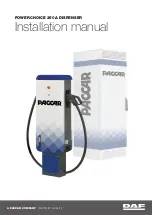
◆
Keep the ventilation slots free of dirt.
◆
Do not charge several batteries simultaneously.
◆
Do not short-circuit the charging clamps.
◆
The power supply cable and the charging leads have to be in perfect condition.
◆
Keep children away from the battery and the charger.
◆
Danger! An acute risk of explosion exists if there is a pungent smell of gas. Disconnect the charging
clamps, ventilate the room immediately and thoroughly, have the battery inspected by a customer service
workshop.
◆
Never use the cable for any purpose other than its intended ones. Do not carry the appliance by its
cable and never pull on the cable to remove the plug from the socket-outletl. Protect the cable from heat,
oil and sharp edges.
◆
Indicate the polarity correctly, the anode is red or
“
+
”
sign, the cathode is black or
“
-
”
sign.
▲
Caution! Battery acid is corrosive. If any acid is splashed on your skin or clothes, wash off immediately
with wter(for 15 minutes) and consult a doctor if necessary.
◆
If the fuse along side the charging current indicator becomes defective, replace it with a fuse of
identical amperage.
◆
Keep the terminals clean and protect them from corrosion.
◆
Always disconnect the appliance from the power maintenance work.
◆
Wear acid-proof safety gloves and goggles whenever you connect up and charge the battery and
whenever you fill in acid or top up with distilled water.Have repairs carried our only by a qualified
electrician.
◆
Disposal : disposal of unwanted batteries only via automotive workshops, special battery collection
stations or special waste collection centers. Ask your local authorities for details.
◆
Disconnect the supply before making or breaking the connections to the battery. If the power cord is
damaged, it must be replaced by the manufacturer or its service agent or similarly qualified person in
order to avoid a hazard.
◆
The cathode of battery charger not connected to the chassis of vehicle has to be connected first. The




































